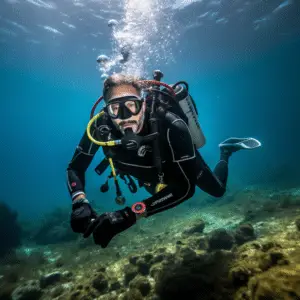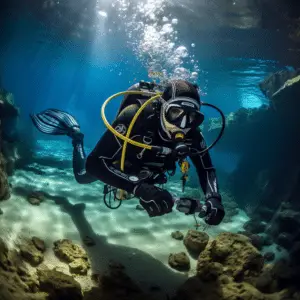Divers can greatly boost their skills through exercise and stretches. These techniques help with flexibility, endurance, and mastering new dives.
It’s important to do core strengthening exercises. Planks, side planks, and supermans build a strong core for stability and control.
Shoulders are crucial when diving. Doing arm circles, shoulder stretches, and external rotations keeps shoulders in shape.
Proper breathing techniques also help. Deep diaphragmatic breathing relaxes and maintains buoyancy.
Mark was an aspiring diver who had trouble with dives. But after exercising, stretching, and focusing on breathing, he improved his skills. He now dives with precision and grace.
Importance of Diving Skills

Proficient diving skills are essential for both professional divers and recreational divers. They help to safely explore underwater environments and discover the wonders of the deep. To improve these skills, specific exercises and stretches should be practiced. Lunges, squats, and planks build core stability and leg strength, while shoulder rotations and calf stretches boost flexibility. Additionally, diaphragmatic breathing and breath-holding techniques help divers control their air consumption.
Here’s a true story to emphasize the importance of proper training. A professional diver was reluctant to invest time in honing his skills. But, during a deep dive, he faced difficulty due to lack of strength and flexibility. Diving Skills Improvement, This made him realize the significance of physical preparation. Diving Skills Improvement, He included regular exercises in his training routine and saw remarkable improvement in his underwater abilities. Not only that, but he also felt more confident and enjoyed dives more.
Stretching Exercises for Diving Skills Improvement
Diving athletes need great skills. To get them, add stretching exercises to your training. These exercises help with flexibility, balance, and performance. Here are 6 exercises designed to improve diving:
- Pike stretch: Sit, legs out, bend at the waist, and reach for your toes.
- Butterfly stretch: Sit, soles of feet touching, hold ankles, and press knees down.
- Shoulder stretch: Stand, clasp hands behind the lower back, straighten arms, and squeeze shoulder blades.
- Hamstring stretch: Lie on your back, one leg extended, use a strap or towel to pull the leg towards you.
- Quadriceps stretch: Stand, bend one knee, bring the foot to glutes. Reach back with the same hand and hold the ankle or foot. Pull until you feel a stretch in front of the thigh.
- Calf stretch: Face a wall, one foot slightly forward, lean into the wall until you feel a stretch in the calf muscle.
These exercises target specific diving muscles and increase flexibility. Doing them regularly can cut the risk of injury and boost diving skills. Before diving practice, always warm-up. Talk to a coach or trainer to find out which stretches are best for you.
Greg Louganis, Olympic gold medalist, used stretching exercises to help with his dives. He was able to do complex dives with precision and grace. This proves the value of stretching for dive training.
Strength Building Exercises for Diving Skills Improvement
Want to take your diving to the next level? Incorporating strength-building exercises into your training can make a big difference! Diving Skills Improvement, These exercises will help you develop the muscles used in diving, giving you more power and control. Here are four key points to consider:
- Weighted Squats: Add weight to your squats to help strengthen your leg muscles, which are key for diving propulsion.
- Push-ups: This exercise targets your chest, shoulders, and triceps for better upper body strength and stability while diving.
- Plank Holds: Engage your core muscles with plank holds to maintain a stable body position while diving.
- Lunges: Target your quadriceps and glutes with lunges for better knee stability and lower body strength for take-offs and landings.
On top of these exercises, be sure to focus on specific stretches that focus on flexibility. Stretching your calves, hamstrings, hip flexors, and shoulders can improve your dive performance with greater range of motion.
Remember to prioritize safety when doing any exercise routine. Get help from a certified trainer or coach to guide you based on your skills and needs.
A fun fact? Olympic diver Tom Daley regularly does strength-building exercises in his training. His commitment to fitness and skill has helped him become one of the best divers in the world.
Dive-Specific Exercises for Diving Skills Improvement
No one answer exists for improving diving skills through exercise and stretches. Diving Skills Improvement, But, here are some dive-specific exercises that can help:
- Build core muscles: Planks, Russian twists, and leg raises will aid in body control and stability in water.
- Breath-holding exercises: Deep breathing and apnea walks will expand lung capacity and help stay underwater longer.
- Flexibility through yoga: Yoga poses boost flexibility and body awareness, both important for accurate dives.
- Train leg muscles: Squats, lunges, and calf raises strengthen muscles for jumping off the board or platform.
- Develop upper body strength: Push-ups, pull-ups, and shoulder presses give strength for arm moves during dives.
Before starting any new exercises, consult a professional trainer or coach. Plus, focus on proper technique when performing dives. Practice different dives repeatedly, paying attention to body alignment, entry angle, and entry position.
Many professional divers find success through regular training routines with these dive-specific exercises. For example, Alex was having difficulty with his diving technique until he incorporated these exercises into his training regimen. Through consistent practice of core-strengthening exercises and breath-holding techniques, he gained control in the water and executed more precise dives. This helped him score higher at competitions and become a professional diver.
By including dive-specific exercises in your training and focusing on proper technique, you can improve your diving skills and reach new heights in the world of diving. So, jump right in and begin your journey to becoming a master diver!
Warm-up and Cool-down Routine
Warm-up and cool-down routines are essential for enhancing your diving skills. They enhance blood flow and flexibility, and reduce the risk of injuries. Here’s a 3-step guide on how to do it:
- Step 1: Start with dynamic stretches, such as arm circles, leg swings and torso rotations. This prepares your body for the dive.
- Step 2: Perform exercises that imitate the movements in diving, like squat jumps, tuck jumps and box jumps. This develops explosive power and coordination.
- Step 3: Finish with static stretches. Focus on stretching the major muscle groups used in diving, like calves, hamstrings, quadriceps and shoulders. Hold each stretch for 20-30 seconds to increase flexibility and reduce muscle soreness.
Remember to take care of your body and stay hydrated. Doing proper warm-up and cool-down sessions will reduce injuries, boost performance and help you reach new heights in diving.
Tips for Proper Technique

To improve your diving skills, proper technique is essential! Here are some tips to ace your performance underwater:
- Focus on body position: Align your head with your spine and press your arms tightly against your ears.
- Controlled breathing: Take deep breaths before diving and exhale slowly while underwater. This will help you retain air and reduce drag.
- Strengthen your core: Working on your core muscles, like your abs and lower back, will help with stability and control.
- Increase flexibility: Do stretches for your shoulders, lower back, and legs to prevent injuries and increase range of motion.
- Master body control: Coordinate your arms, legs, and torso for smoother dives.
Moreover, these aspects don’t only enhance technique but also reduce the risk of accidents. By maintaining an aligned posture, spinal injuries become less likely. Controlled breathing increases oxygen intake, improving mental focus and physical recovery. A strengthened core provides stability during takeoff and prevents strain on the lower back. Flexibility reduces muscle tension, preventing strains or pulls while maximizing range of motion. Lastly, refined body control ensures a graceful dive with less chances of losing balance or landing awkwardly.
Conclusion
Pro athletes need physical strength, agility, and specialized skills. To step up their diving performance, they can do exercises and stretches. These will not only give them increased flexibility, but also help in coordination and technique. Result? Better dives!
To improve diving, core-strengthening exercises like planks and leg raises can be included. These build abdominal muscles’ stability and control, important for balance during dives. Also, yoga poses like the bridge or cobra can increase spine flexibility and help divers get better body alignment in the air.
Besides core exercises, targeted stretches play a key role too. Stretching the hip flexors can enhance leg extension during takeoff and improve body positioning throughout the dive. Furthermore, stretching the shoulders and upper back can boost arm extension during entry into water.
Remember: these exercises and stretches must be done with guidance from a qualified coach/trainer who specializes in diving. This ensures proper technique and reduces injury risk.
USA Diving states that using dryland training exercises in a diver’s routine can significantly boost performance in competitive diving events.
Frequently Asked Questions
FAQs – Exercises and Stretches to Improve Diving Skills
1. What are some exercises to improve diving skills?
There are several exercises that can help improve diving skills, such as:
- Jumping jacks
- Squat jumps
- Core exercises (planks, crunches, etc.)
- Plyometric exercises (box jumps, depth jumps, etc.)
- Leg exercises (lunges, squats, etc.)
2. Are there any specific stretches for divers?
Yes, specific stretches can enhance flexibility and overall diving performance. Some effective stretches for divers include:
- Child’s pose
- Butterfly stretch
- Shoulder stretches
- Hamstring stretch
- Calf stretches
3. How often should I do these exercises and stretches?
The frequency of exercises and stretches depends on your training routine and fitness level. Generally, it is recommended to perform these exercises at least three times a week and incorporate stretching into your warm-up and cool-down routines.
4. Can these exercises and stretches help prevent injuries?
Yes, incorporating these exercises and stretches into your regular diving training can help strengthen and improve flexibility, reducing the risk of injuries. However, it is essential to ensure correct form and technique while performing them.
5. Are there any exercises specifically for improving diving entry technique?
Yes, there are exercises that can help improve your diving entry technique. Some of these include:
- Vertical jumps
- Practice dives
- Entry-position drills
- Trampoline work
6. Should I consult a diving coach or trainer to learn these exercises?
While many exercises and stretches can be done individually, it is advisable to consult a qualified diving coach or trainer to ensure you are performing them correctly and to get personalized guidance based on your skill level and goals.
